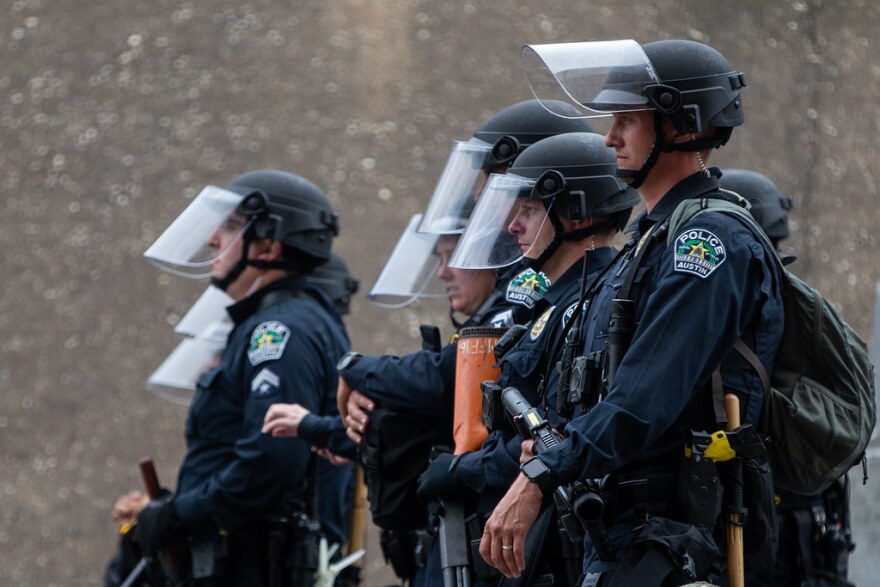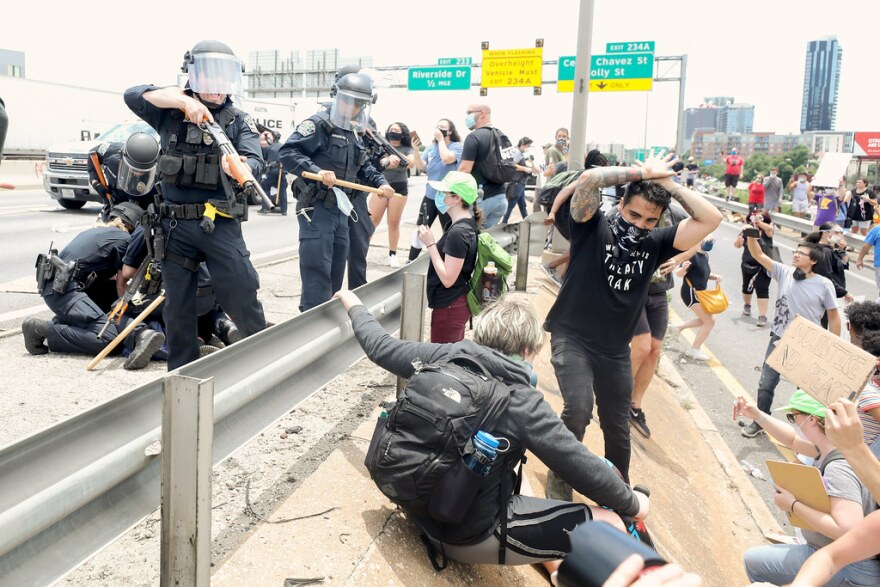This story was reported jointly with Alain Stephens of The Trace, a nonprofit newsroom reporting on guns in America.
On June 1, Austin Police Chief Brian Manley was close to tears as he provided an update on protesters injured by police. In the days before, his officers had fired indiscriminately on Black Lives Matter demonstrators outside his department's headquarters with what are typically called “less lethal rounds” – and had sent several people to the hospital with serious injuries, including a 16-year-old-boy who sustained brain damage.
Manley characterized the injuries as "not what we set out to do as a police department."
Days later, before an emergency meeting of the Austin City Council, Manley pledged his department would never again use the beanbag rounds, which contain lead pellets and are fired from a 12-gauge shotgun, for crowd control.
“We are learning some very difficult lessons,” he said.
But despite his proclamation of reform, Manley’s department was quietly moving to restock its cache of less lethal rounds.
The day after Manley appeared at City Council, the city moved to finalize a $42,000 order with Combined Tactical Systems, a global riot gear supplier. Under the contract, obtained by KUT and The Trace, the city agreed to purchase more than 5,000 rounds of 12-gauge Super-Sock beanbags, along with 500 foam-tipped munitions, which are fired from 40 mm grenade launchers.
The city rubber-stamped another contract for 5,000 beanbag rounds on Aug. 17.
The Austin Police Department declined to comment on the timing of the purchases. The department “will make purchases to restock inventory to ensure we have enough supply to issue to officers and be used in required annual qualifications which start after the first of the year,” a spokesperson said in a written response.

The department is also investigating whether the rounds used on protesters were expired, which could have contributed to the severity of the injuries.
Ahead of Election Day and possible demonstrations, city leaders have renewed questions about the department's use of less lethal rounds. In an Oct. 29 letter, four City Council members asked Manley whether he would hold true to his pledge against using the rounds to control demonstrations, asking for "guarantees [that] the harm caused at these protests by our own department will not happen again."
Demonstrations against racial injustice and police violence erupted in Austin in late May. The police response was swift and severe, with widespread use of tear gas, in addition to the less lethal rounds. Footage on social media showed images of 16-year-old Brad Ayala being shot in the head with a beanbag round by an officer. Then came footage of Justin Howell being hit: A beanbag round penetrated the 20-year-old’s skull, leaving him with brain damage.
APD’s conduct received national media attention for its severity and the injuries inflicted on demonstrators. Seven Austin police officers were placed on administrative leave for their actions.
The Austin Police Department’s apparent resistance to reform doesn’t shock advocates for the city’s Black and brown communities, which have borne the brunt of police violence.
“They don’t want to change, like many of us don’t,” said Chas Moore, the founder and executive director of the Austin Justice Coalition, a nonprofit that has been leading demonstrations and calls for increased police accountability for years. “But the cops don’t have a choice, because they have the power to kill people.”
On Oct. 20, Anthony Evans, a 26-year-old Austin man, filed a federal lawsuit against the APD over injuries sustained during the demonstrations. Evans was shot in the face with a beanbag round while at a protest, leaving him with a fractured jaw that required emergency surgery. He will likely require more surgeries, his lawyer, Jeff Edwards, told KUT.

Edwards is also representing Maredith Drake, a street medic who was injured on May 31 while she cared for Howell.
“It's not enough for Chief Manley to come before the City Council, offer thoughts and prayers, and after two full days of calls for his firing and termination to say, 'Hey, we're not going to do this anymore,’” Edwards said. “A 12-year-old would've known not to do it anymore before it happened. You don't shoot guns at people with very little control of where the ammunition is being fired. You just don't do that."
Edwards said the department’s commitment to pare back the use of beanbag rounds is “meaningless,” as loopholes allow officers to shoot them.
At the June 4 City Council meeting, Manley stressed that beanbag rounds were still an “appropriate tool in other circumstances and so, it is still approved for use,” in situations other than crowd control.
Austin Council Member Greg Casar said he found Manley’s comments lacking. He pointed out that Ayala, the 16-year-old victim, was not protesting when he was shot; the boy was standing alone on an embankment.
“Changing the policy for crowds would not have changed this,” Casar said.
It’s this distinction that led the Austin City Council to pass a resolution in August restricting the use of less lethal rounds, with an exception for incidents that present “an imminent threat of death or serious bodily injury.” It wasn't an outright ban, although council members did express they didn't want beanbag rounds to be included in the next year's budget. The council also convened a task force charged with “reimagining” policing and determining whether the department should ban the rounds altogether.
The vote came after the city had entered negotiations with Eagle Pride Supply for 5,000 beanbag rounds at a cost of $24,850. The contract was awarded days later, on August 17, and the shipment was later delivered to the APD’s Southeast Austin training academy.
Kathy Mitchell, a policy coordinator with the criminal advocacy group Just Liberty, said the timing of the contracts is alarming.
“Should [Manley] have pursued this order? No,” she said. “Until we have clear rules put into the police policy manual articulating the limited, if any, cases when they can use these munitions, they’ve just wasted taxpayer dollars.”
History Of Violence
Police have long struggled to find safer alternatives to guns to control crowds and break up civil disturbances. Since the 1970s, departments have used iterations of “kinetic impact projectiles,” which are designed to inflict blunt force trauma instead of permanent injury or dismemberment.

However, these rounds still present significant risks. According to a 2017 analysis of nearly 2,000 injuries sustained by kinetic projectiles, nearly 3 percent of people died, and another 15 percent were left permanently disabled.
The iteration of these projectiles favored by American police, including the Austin Police Department, is the “beanbag” round, essentially a fabric sack of lead pellets that can be fired from a 12-guage shotgun at up to 300 feet per second.
As beanbag rounds gained popularity in the early 2000s, doctors began observing their devastating effects. In 2001, the Annals of Emergency Medicine published a report warning doctors of a variety of injuries – such as pierced flesh, shattered testicles and death – after more police departments started using the projectiles. Other reports warned of punctured lungs, brain bleeding and bacterial infection.
In 2002, the Huntington Beach Police Department sued Defense Technology, a California-based riot gear maker, after officers nearly killed a man when a beanbag embedded into his chest. That same year, the City of Los Angeles paid $2.5 million to a woman whose eye was obliterated when she was shot during a case of mistaken identity.
Defense Technology, one of the world’s largest producers of beanbag rounds, said in a 2003 report regarding safety testing that “most of this research had been carried out by the Army and the information is somewhat difficult to obtain.” The report also highlighted that beanbags rounds shouldn’t be used on the face or neck, and found that the projectiles carried the kinetic impact of a .22-caliber bullet.
Nearly two decades later, bean bag rounds produced by Defense Technology were among those used on protesters in Austin.
"The assumption ... is that police know what they're doing, and very frankly that's not the case in a lot of cases."
By 2004, beanbag rounds garnered the attention of the National Institute of Justice, the academic research arm of the Department of Justice. In a report released that year, the NIJ determined beanbags rounds were the most popular kinetic impact weapon used by police, and that their use had led to a number of severe injuries and eight deaths. The study concluded more data was required to “identify deficiencies in the manufacture of impact munitions and in the training and use of the weapons in real life situations.”
However, as of 2020, there are still no federal standards for production, use or testing of less lethal munitions.
“There’s nothing in place that says that you can’t do this,” said Michael Sierra-Arévalo, a UT sociology professor who specializes in policing. He noted that police technology is often introduced with little scrutiny, often at the behest of a now burgeoning, lucrative and influential private industry dedicated to arming law enforcement.
“The assumption in large part for as long as we’ve had police in the U.S. is that police know what they’re doing,” Sierra-Arévalo said, “and very frankly that’s not the case in a lot of cases.”
The global market for less lethal munitions is valued at $877 million and is expected to grow to $1.2 billion by 2027, according to Grand View Research, a market intelligence firm. The largest customer is the U.S., due to its high police and military spending.
Yet, warnings from the medical community and a lack of regulation hasn’t dissuaded police departments from adopting the widespread use of less lethal rounds. In Austin they were pitched as a means of reform. In 2004, Police Chief Stanley Knee announced the acquisition of beanbag rounds as a pillar of his three-point plan to modernize the department. The plan was, in part, a reaction to complaints of excessive force used on the city’s Black community.
Human Impact
The city's Office of Police Oversight, the third party that oversees use-of-force complaints, fielded 895 complaints relating to the department’s actions between May 29 and June 10. The office called for the department to formally investigate 227 incidents. (That same office received a total of 50 formal complaints in all of 2018 and 2019 combined.)
Following the protests, trauma physicians at Ascension Seton Hospital in Austin drafted a letter to the New England Journal of Medicine that documented the injuries protesters sustained over a two-day period.
The letter, published in August, catalogs how doctors ended up treating 19 patients, eight of whom required surgery. Doctors repaired torn scalps and bleeding brains and removed a beanbag lodged in the jaw of a 29-year-old woman.
“Any competent police officer who does any sort of training or [has] any sort of knowledge – who’s ever read a manual on these things – knows that you can’t be firing these things from long distances with any sort of accuracy,” said Edwards, the attorney suing the city on behalf of victims. “And to have officers doing that during a protest against police violence – I’d have to go back to the days of the marches on Selma to capture that kind of irony.”









